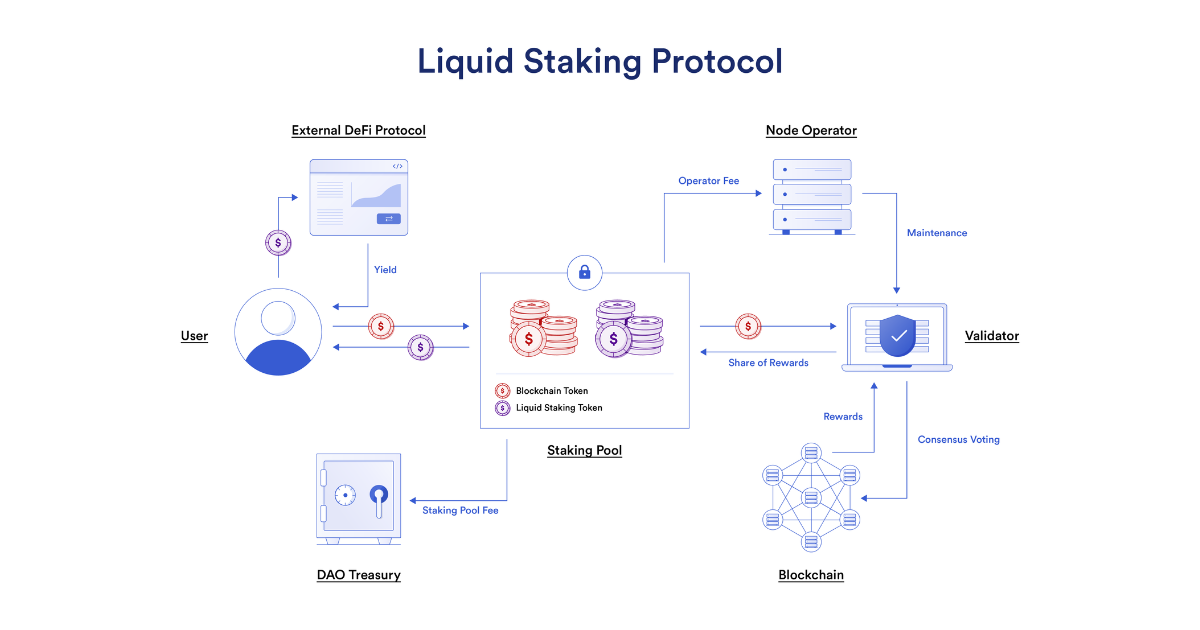The traditional staking concept has a problem. Sure, you can earn rewards by locking your liquidity in in Proof-of-Stake (PoS) blockchains. But the issue with Ethereum staking and other PoS staking is that you can’t use your locked liquidity for anything else—until you withdraw it. And withdrawing means you no longer enjoy the rewards that come with staking. Big bummer.
But what if you could still stake your liquidity AND spend it? That's essentially what liquid staking offers. Liquidity staking takes everything that’s good about its traditional concept and amplifies it, allowing you to have your cake and eat it too.
Now, surely, liquid staking still has some potential risks, and it's not as grand as it sounds.
Term of the day: Liquid staking
— Ankr (@ankr) November 5, 2021
Pioneered by StakeFi, liquid staking is a model that makes your staked funds instantly available. Instead of waiting for the lock-up period to expire, you can trade, lend or become a liquidity provider, while still accumulating staking rewards. pic.twitter.com/1kYmSZyEeW
This in-depth article explains exactly how liquid staking works and its benefits. We’ll also cover its potential risks and show you some major protocols offering liquid staking.
What is Liquid Staking?
Liquid staking is a process that allows cryptocurrency holders to stake their assets while retaining liquidity through the issuance of derivative tokens. These tokens are called liquid staking tokens (LSTs), and they represent the staked assets.
You can use them for pretty much everything the original tokens can do. You can trade LSTs, use them as collateral, or even re-stake them on other DeFi platforms.
The main reason liquid staking exists is to solve the illiquidity problem that comes with traditional staking. In conventional staking, users lock up their tokens to support network operations and security. And these lockups usually stay that way for months or even years.
During this time, you cannot access these staked assets or even use them for other purposes. Liquid staking overcomes this limitation by providing users with LSTs, which they can use in the other DeFi ecosystem while their original assets remain staked.
As users stake their assets, the liquid staking protocol manages the validator nodes and handles the technical aspects of staking. This allows even those without technical expertise to participate in network validation and earn rewards.
How Does Liquid Staking Differ from Traditional Staking?
The key differences between liquid staking and traditional staking lie in the flexibility and utility of the staked assets:
- Liquidity: Traditional staking locks up assets, while liquid staking provides immediate liquidity through LSTs.
- Utility: Staked assets in traditional models are idle, whereas liquid staking allows for participation in various DeFi activities.
- Accessibility: Liquid staking often has lower entry barriers, enabling participation with smaller amounts of tokens.
- Rewards: Both methods offer staking rewards, but liquid staking can provide additional yield opportunities through LST utilization.
What Are the Benefits of Liquid Staking?
Liquid staking offers several advantages over traditional staking methods. The most obvious is that it allows you to earn more rewards with the same liquidity.
So basically, you can stake your token, take LST, restake it, take the LST from restake to restake… I know, I know.
My first crypto/staking meme! Based on a very true story 🧠:#STAKING #cryptomemes pic.twitter.com/mFIkg72sYx
— Josh (@FaierPlay) January 17, 2022
Let’s cover all the benefits.
Enhanced Liquidity and Capital Efficiency
Liquid staking allows users to access the value of their staked assets through derivative tokens. This means you can use your staked assets in other financial activities without unstaking. As a result, your money isn't sitting idle and can work for you in multiple ways at once. This increased efficiency helps you make the most of your cryptocurrency holdings.
Dual Rewards and Yield Opportunities
With liquid staking, you can earn two types of rewards. First, you get the usual staking rewards for supporting the network. Second, you can earn extra yields by using your liquid staking tokens in DeFi platforms. This double-dipping approach can potentially boost your overall returns compared to traditional staking alone.
Flexibility and Accessibility
Liquid staking gives you more control over your staked assets. You can easily trade your liquid staking tokens or use them in DeFi without long unstaking periods. This flexibility allows you to respond quickly to market changes or personal financial needs without losing your staking position.
Reduced Entry Barriers
Many liquid staking protocols have lower minimum requirements than running a full validator node. This makes staking more accessible to a wider range of users, including those with smaller amounts of cryptocurrency. As a result, more people can participate in network validation and earn staking rewards.
Simplified Staking Process
Liquid staking protocols handle the technical aspects of staking, such as running validator nodes and managing blockchain interactions. This simplifies the staking process for users who may not have the technical expertise or resources to stake independently. You can start earning staking rewards with just a few clicks, without worrying about the complex backend operations.
Diversification of Staking Positions
Liquid staking allows you to easily spread your staking across different networks or providers. You can hold liquid staking tokens from various protocols, potentially reducing your risk if one network or provider faces issues. This diversification can help create a more balanced and resilient staking portfolio.
What Are the Risks and Limitations of Liquid Staking?
The main reason liquid staking is so attractive is the same reason why it's risky and unsustainable. The whole staking to restake loop just sounds too good to be true—kind of like a Ponzi scheme.
Let's examine the main risks of liquid staking:
- Ponzi-like structure
- Market-related risks
- Loss of original assets
- Dilution of community engagement
Ponzi-like Structure
The ability to repeatedly stake liquid staking tokens (LSTs) creates a cycle that resembles a Ponzi scheme. For example, staking ETH to get stETH, then staking stETH to get lpETH, and so on, adds more leverage to the original asset with each cycle. This process doesn't create any new value at all. Instead, it builds a potentially unstable structure that could collapse dramatically.
Market-related Risks
LSTs can lose their peg to the original asset, as happened with stETH in the past. This depegging can lead to significant losses for users. The value of LSTs is not directly tied to the underlying asset. So, any crazy market news could make it lose its peg.
Loss of Original Assets
Contrary to some beliefs, staking your assets through liquid staking does not guarantee their safety. There's a real risk of losing your original tokens if something goes wrong with the staking protocol. As Duo Nine pointed out, "if you think your ETH is safe in stETH, it's not!".
Dilution of Community Engagement
Liquid staking and restaking tokens can dilute the value of community engagement. As Kristi noted, "LRT/LST metas have lost sight of the goal of restaking." The original purpose of engaging token holders as a bootstrapping community becomes less effective when you start introducing multiple layers of derivative tokens. What this does is attract short-term flippers rather than committed community members.
Which Are the Major Liquid Staking Protocols?
Now that you know the good, bad, and ugly of liquid staking, let’s cover the big dawgs in the industry. The major players we’ll cover include Lido Finance, Rocket Pool, Ankr, and Chainlink.
- Lido Finance: Lido is the largest liquid staking protocol, supporting multiple networks including Ethereum, Solana, and Polygon, and issuing stETH, stSOL, and stMATIC tokens respectively.
- Rocket Pool: Rocket Pool is a decentralized Ethereum liquid staking protocol that issues rETH tokens and allows users to run minipool validators with lower ETH requirements.
- Ankr: Ankr offers a multi-chain liquid staking solution supporting various networks such as Ethereum, BNB Chain, and Avalanche, issuing tokens like aETH, aBNBc, and aAVAXc.
We’re just getting warmed up 🚀 pic.twitter.com/KokzfufnDh
— Ankr (@ankr) July 19, 2024
- Chainlink: While primarily known for its oracle services, Chainlink also offers staking for LINK token holders, aiming to enhance oracle network security while providing staking opportunities.


Disclaimer: All materials on this site are for informational purposes only. None of the material should be interpreted as investment advice. Please note that despite the nature of much of the material created and hosted on this website, HODL FM is not a financial reference resource and the opinions of authors and other contributors are their own and should not be taken as financial advice. If you require advice of this sort, HODL FM strongly recommends contacting a qualified industry professional.





